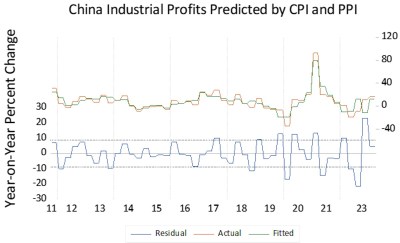To gauge price behavior, rather than the overall index number, economists look at so-called “core” consumer price inflation that excludes volatile food and energy prices – except when it comes to China.
“China sinks deeper into deflation as prices fall at fastest rate in 15 years” was CNN’s headline this morning. But the 0.8% January drop in China’s consumer price index reflected a 17% drop in pork prices. Core CPI rose by 0.4% in January. That’s 4.7% core inflation at a compound annual rate – hardly consistent with deflation.
Besotted with the notion that China’s economy is collapsing, the Western media interpret every economic report from China with that bias – even if it means turning common sense and causality inside out. A simple examination of China’s recent price data tells a different story.

The Producer Price Index (PPI) —the cost of wholesale goods – continued to fall while core consumer prices rose. That’s a problem for producers of nylon fiber (for example) whose prices have fallen by 12% year-on-year, but it isn’t necessarily a problem for the overall Chinese economy.
The good news is that rising consumer prices and falling producer prices boost corporate profits. Industrial enterprises are charging higher prices to consumers – and paying lower prices to suppliers.
China’s PPI isn’t exactly a proxy for industrial input costs, and core CPI isn’t exactly a proxy for final prices, but industrial profits have risen with a falling PPI and a rising core CPI during the past dozen years.
A linear regression equation (using breakpoint analysis) shows that year-on-year changes in core CPI and PPI explain about 76% of the variation in year-on-year industrial profits. The predictive variables are significant after correction for serial correlation.

Broad measures of price performance conceal opposing trends. Auto prices are falling in China due to rising productivity and ferocious competition among automakers, and that’s a good thing.
Housing prices are falling, and that’s a mixed thing: It’s bad for older Chinese who have most of their savings in property and good for young families looking for a home.
But econometric analysis strongly supports the notion that falling producer prices and rising consumer prices are good for industrial profits.

